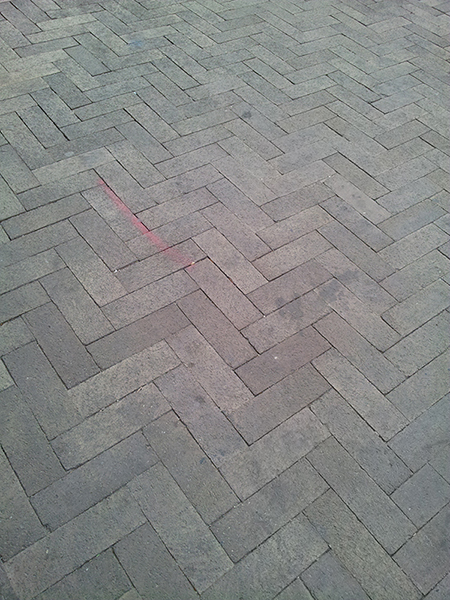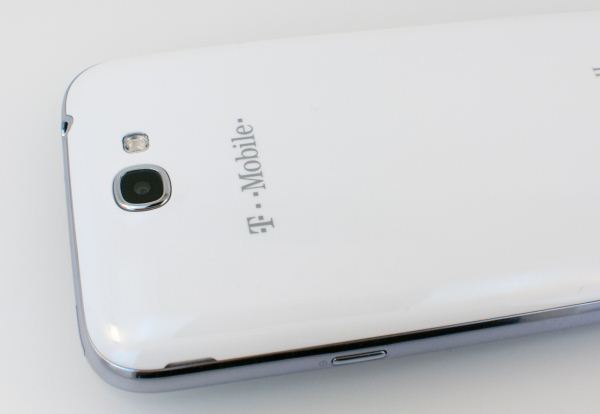Samsung Galaxy Note 2 Review (T-Mobile) - The Phablet Returns
by Brian Klug on October 24, 2012 9:00 AM ESTThe Galaxy Note 2 is very much an enlarged, slightly tweaked Galaxy S 3, and nowhere is this more evident than the camera system. In fact, after lots of digging I’ve determined that almost all of this is exactly the same as the Galaxy S 3, which isn’t a surprise at all. Samsung has tweaked the camera UI and added features, and compared to the Note there’s definitely a marked improvements, but for Galaxy S 3 users the experience is entirely the same.
To start, the Galaxy Note 2 uses the same 8 MP S5C73M3 CMOS as Galaxy S 3 on the rear facing camera, which is a CMOS which on paper has specs up to par with the competition. There's no official disclosure about this part, but people still know about the specs. Optical format is 1/3.2" which is very common right now, 1.4µm square pixels, and of course the sensor is backside illuminated. From what I can tell the optical system on top of that is exactly the same as well, F/2.6 with a focal length of 3.7 mm. From what I’ve seen of the Galaxy Note 2 camera, performance is as expected basically the same as Galaxy S 3.
Likewise the front facing CMOS is a S5K6A3, also same as Galaxy S 3, which is 1/6" format with 1.75µm BSI pixels and a total size of 1412 x 1412 pixels. Captured images end up being 1280 x 960, F/2.8 with focal length of 2.5 mm.
.gif)
Milbeaut ISP Roadmap
In addition, Samsung continues to use a discrete Fujitsu Milbeaut 5th generation ISP (Image Signal Processor) for their cameras, you see references to this as M5MO throughout. This is the same setup as I saw on the Galaxy S 2, and though I didn’t dig into the original Note I bet it’s there too since that camera was analogous. There wasn’t much of a jump in camera performance between the Galaxy S 2 and 3, it seems as though Samsung is largely content keeping things the way they are this generation, perhaps waiting for the next generation of the Milbeaut ISP or a dramatically different CMOS to come around from Samsung Semiconductor before they mix things up. Meanwhile F/2.6 isn’t the most aggressive target for a fast optical system, considering other players are at F/2.0. I think Samsung expects those interested in a smartphone with emphasis on camera to go after the Galaxy Camera or something.
 This sign just comes off sounding so sarcastic (sample Galaxy Note 2 Photo)
This sign just comes off sounding so sarcastic (sample Galaxy Note 2 Photo)
To evaluate still image quality we turned to our standard set of tests which seems to keep growing. That consists of a scene in a lightbox with constant controlled illumination of 1000 lux taken using the front and rear cameras with as close to the same field of view as possible, images of a distortion grid, GretagMacbeth ColorChecker card for white balance checking, and an ISO12233 test chart for gauging spatial resolution in an even more controlled manner. Because I’ve moved houses and lighting will never ever be exactly the same, I have decided to move the three test charts into my lightbox as opposed to putting them on a wall and illuminating them with studio lights. This warrants a completely new set of comparison images, hence the smartphone 2012 camera bench for the three charts and front facing camera.
There’s a lot to go through here, but the test charts tell the most objective story. To me, flipping back an forth between Galaxy S 3 and the Samsung Galaxy Note 2 confirms what I already know, that performance is very similar between the two because they’re basically the same system. Locations 3–7 remain in the bench photo locations, and unfortunately due to time constraints I could only get photos on the one day I was in town with some overcast skies and not the usual lighting I like.
Honestly probably the biggest improvement over the original Note is that the center purple colored spot is completely gone as you can see with the following toggle.

Samsung’s camera UI continues to be very comprehensive and offer a wealth of options and shooting modes. I spent a lot of time playing around with HDR, which now has a Normal and Strong mode that adds even more dynamic range with exposures bracketed even further from the center. There are a couple of those in the MISC gallery of camera shots.

































































131 Comments
View All Comments
name99 - Wednesday, October 24, 2012 - link
Of course you could consider this an empirical display of the difference between Apple supporters and Apple haters. The Apple supporters don't seem to feel a compulsive need to wander into a non-Apple thread and tell everyone how much Android, Samsung, Google, AMOLED, S-Pen and TouchWiz all suck.Either way, yes, a thread that does't feel like a wanna-be gang fight between two groups of 8-year-olds is a pleasant experience!
Peanutsrevenge - Thursday, October 25, 2012 - link
If it helps:Droid fanatic
http://www.youtube.com/watch?v=7huae767Rxg&fea...
Apple Fanatic
http://www.youtube.com/watch?v=FFhjDX-DUew&fea...
http://www.youtube.com/watch?v=kTTSsB92L_s&fea...
Came across these yesterday on Phandroid :D
Mugur - Wednesday, October 24, 2012 - link
As owner of a 5" Dell Streak, I'm looking to replace it with another large phone and Note 2 seems just perfect. One question though: can I use another launcher (I don't like TouchWiz) without losing the S-Pen features?Spunjji - Wednesday, October 24, 2012 - link
I use Apex launcher, S-Pen stuff all works fine. :)Mugur - Thursday, October 25, 2012 - link
Thank you.Aenean144 - Wednesday, October 24, 2012 - link
"we load webpages at a fixed interval until the handset dies, with display set at exactly 200 nits as always. The test is performed over both cellular data and WiFi. The new test has decreased pause time between web page loads and a number of JavaScript-heavy pages."What's the pause time?
In such a test, the system that is fastest to idle will typically result in a lower or lowest power draw through time. One can only interpret the performance of a device relative to other devices when doing the specific test, maybe. No one should be assuming that they'll get 10 hours of wifi/cellular browsing though, whatever time your device of choice gets.
Do humans really do what the battery life test does? I don't know if we're at the point where we are input saturated on how fast we can web browse, but I don't think we're at the saturation point just yet. So, if a phone downloads and renders web pages faster, I think we would just browse more pages in the same given time frame. The devices that burn more power during download and render times may end up with shorter battery life performance simply because a user is browsing more and faster.
You guys are definitely promoting the idea of wider "dynamic range" on battery performance. The battery life test is perhaps a light use case based on my gut feel. Minimally, I think, at least for web browsing, the minimum battery life performance should at be established for devices.
Lighter and lighter browsing workloads would tail off towards standby time. You may want to establish or guess at what the max work rate for humans is while browsing the web, like using an average reading speed or maybe somewhere in the 80th percentile of reading speed.
Obviously, it's a more than one parameter problem with games, GPS, etc, but maybe that can be tackled later.
Sabresiberian - Wednesday, October 24, 2012 - link
Of all the smart phones I know about, this is the one I'm most interested in. However, I'm a Windows kind of guy, tried Android briefly and I certainly see why people would choose it over iOS, but in my opinion it's not great. Just my personal view, of course. I'm Windows trained and Windows is the most "intuitive" for me, largely because of that I'm sure.So, in case anyone from Microsoft is reading - can we get Nokia to make something like this with Win 8 as the OS?
On Verizon? (I have to say though, Verizon's methodology for keeping their phones up-to-date doesn't thrill me. Of course, cell phones, particularly smart phones, are about as private as a house made entirely of screen doors anyway, so I'm not sure that's all that important as things exist today.)
;)
shortylickens - Wednesday, October 24, 2012 - link
Got one this afternoon (not because of the article).My local store had them for 200 and also a 50 dollar mail in rebate. I dont think thats nationwide though.
I like it, made an informal review in the forums.
zilexa - Wednesday, October 24, 2012 - link
Really, you have a Note 2 without split screen functionality? So you cannot see and work with 2 apps at the same time??Thats weird! Here in Holland I cannot walk the street without seeing billboards showing off this feature.. those Apple fans don't know what hit them.. firstly iOS 6 wich feels like 2010 version of Android for Android users, now this Note 2 can even show 2 apps at the same time, side by side!
Really weird the US versions don't have this firmware yet. But like you said in other reviews, US market is totally different. Here we see Samsung phones, in the shops, there you see AT&T or T-mobile or Verizon phones. Although here in NL almost always sold with subscription, and with the name of your provider on it, at least its an actual Samsung phone and not a T-Mobile phone..
Impulses - Thursday, October 25, 2012 - link
What? They're all still Samsung/HTC/etc branded in the US... What are you going on about? The carriers do meddle with updates and the firmware, but the thing isn't sold as an AT&T Galaxy S or something, it still says Samsung and it's advertised by Samsung (for better or worse, their anti-Apple commercials are almost as bad as Apple's old anti-PC commercials)...Hell my Sprint HTC EVO 4G LTE doesn't even have Sprint silkscreened anywhere on the front (amazing show of restraint on their part). AT&T's often the worse about branding, they've put the name AND logo on some Moto phones (centered no less).